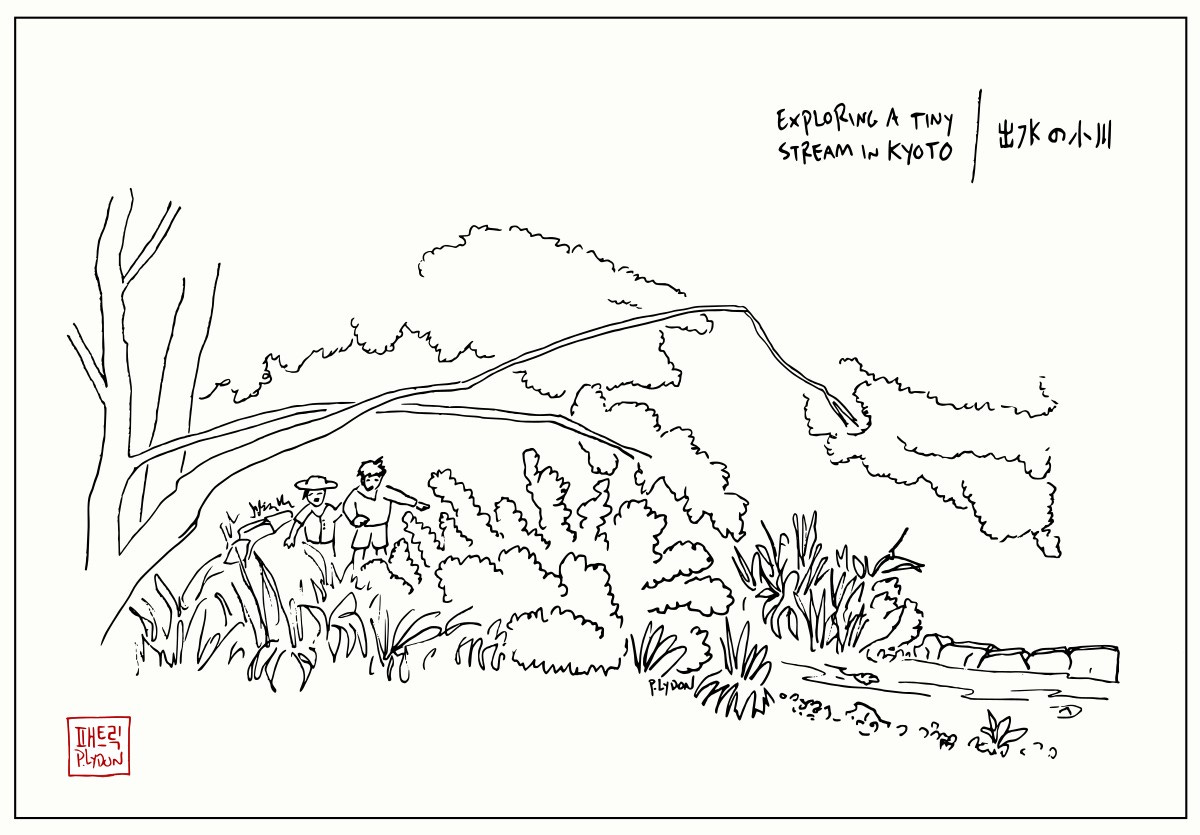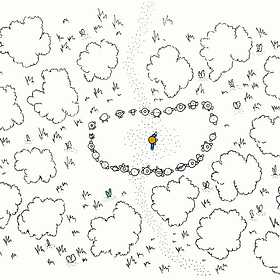This week, three more illustrations from our recent short trip to Kansai region of Japan, for art, music, and gathering supplies for our house rebuilding project. Along with the illustrations, some notes and thoughts — on connection and division.
—
Sitting under a tree in Kyoto, I watch two kids play in a stream. They walk with surprising care, as the younger one hangs onto the sleeve of the older one. Both are wide-eyed however, observing signs of life in the tiny flow of water. Every now and then, they laugh or scream in amazement.
This kind of thing makes a person feel a little bit better about the world. A little more connected to it when, right there in front of us, two humans are deeply into the world in a way we adults rarely are.
Through the wonderment of those kids, I can remember what a miracle it is.
This little bit of water, moving by gravity from one place to the next, supporting all kinds of life in the process, including ours.
This little bit of water, inherently connected to those kids, to me, and to everyone and everything else.
And yet I wonder, besides myself, where all the adults are in this scene.
Of course, the people living here are mostly at work.
And the tourists — who double the population of this city on days like today — are more attracted to the shops and buildings, escaping the humid heat.
Understandable. It is 40 (104 F) degrees outside.
The hottest day in Kyoto’s recorded history.
Sitting here in the shade though, it seems a city with more trees might be a better long term climate plan than a city with more air conditioners.
—
Kyoto does have the bicycle thing going for them though.
My friend lent me her bicycle today. On the rear fender is a sticker that is over 30 years old — it identifies this as the bicycle of a high school girl. Though I am slightly embarrassed by the sticker, the bicycle works fine, and even on this hot day, I join a fairly large number of other bicycling people on their way from one place to the next.
After ten minutes of gliding on this trusty machine through peaceful side streets, eventually, another river.
The big one. Kamo-gawa.
I find them here. The other adults.
Also, a group of girls with the same sticker as me on their bikes. They giggle.
On the river are people of all ages. They sit and chat. They dance. They run. They rest on the grass. They jump gaily across stepping stones in the water.
That’s more like it.
Dancing and jumping across a river can probably fix more things than we know.
—
Speaking of dancing, later that night in Osaka, a few thousand people come by train and bicycle to a city park. They dance and sing and shout, clink cans of beer and highballs. Though I am different, and though I do not know any of them, I also do not feel like a stranger. We dance together.
Leading us is a minstrel on a stage with a gigantic fabric flower sewn to the middle of her dress. She sings and dances like a beautiful idiot. She and the band spread some kind of contagious energy to everyone.
Meanwhile, the moon looks on and two crows glide across a deep blue evening sky. They land on a tree with a good view of the scene. They must take some kind of joy from this group of wild humans, because they stay for a while.
Taking part in this scene, listening, dancing, smiling, singing, I suddenly feel tears well up — soon they roll down my cheeks, and I laugh.
In this park in the middle of this busy city, there are differences, between people, physical objects, living beings.
There are differences, but there is no real division.
Maybe there is no real division anywhere.
Maybe it just takes the right music, or the right art, or the right social conditions, for us to realize this.
To take action accordingly.
—
After the concert, I walk though the park to catch the Keihan Line train. On the way I pass sweaty joggers, old people with walkers, cyclists, and wildly dressed girls enjoying the night together. The trees sway with a breeze that tumbles gently along the moat, and through them Osaka Castle is lit up like a birthday cake.
There is some proverb somewhere, about how, sometimes the people who seem like idiots, are actually the most wise. Maybe at our best, we are all beautiful idiots, dancing through this life?
Another Story: During another kind of gathering among the trees, we learn another lesson about acceptance — growing food in ways that accept the inherent value in everything.
SHORT #29: A Race to the Daikon
Near the top of the hill we gathered, in the orchard in a circle, although, it would probably look more like an amoeba if you saw it from above. A farmer at the center of this ameoba-shaped circle instructed us.
—
Thanks everyone, for letting me into your world. If you have never commented before, feel free to chime in below, or to introduce yourself. You can help this project grow by thinking of someone else who might like this work, and clicking the magic button below.
Not yet signed up yet to get these stories to your inbox? No problem, you can do that below. You can also join our supremely awesome club of paid subscribers who get special perks from me every now and then.








Yes, yes, yes: “Sitting here in the shade though, it seems a city with more trees might be a better long term climate plan than a city with more air conditioners.”
I really enjoy your writing and drawings. They provoke a strong sense of place. I'll be thinking about this one.